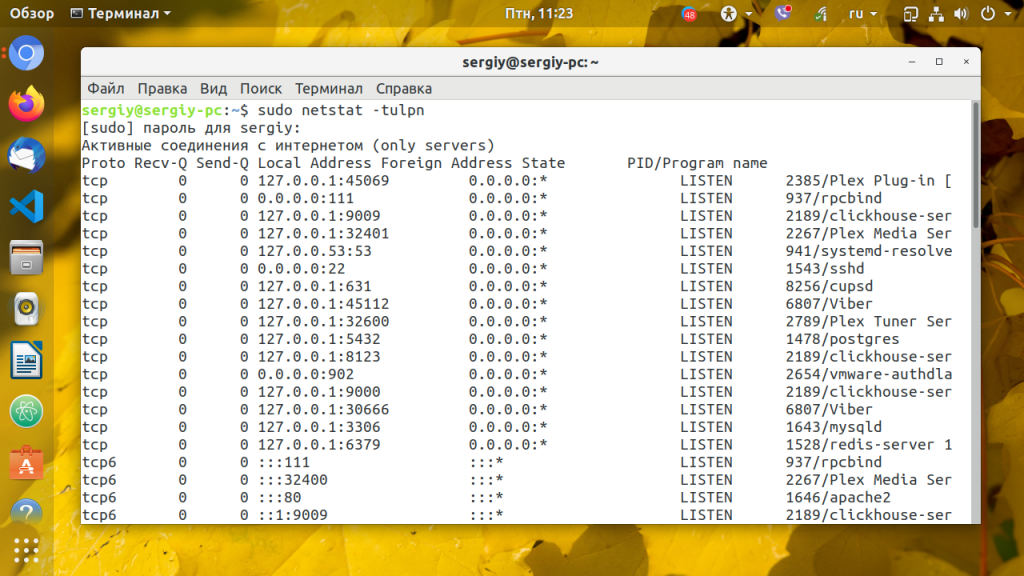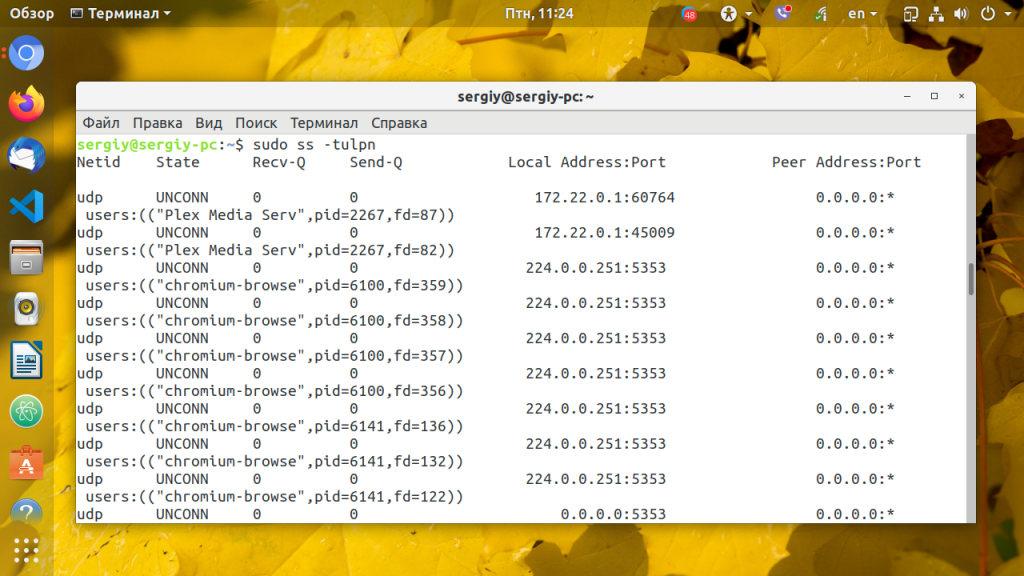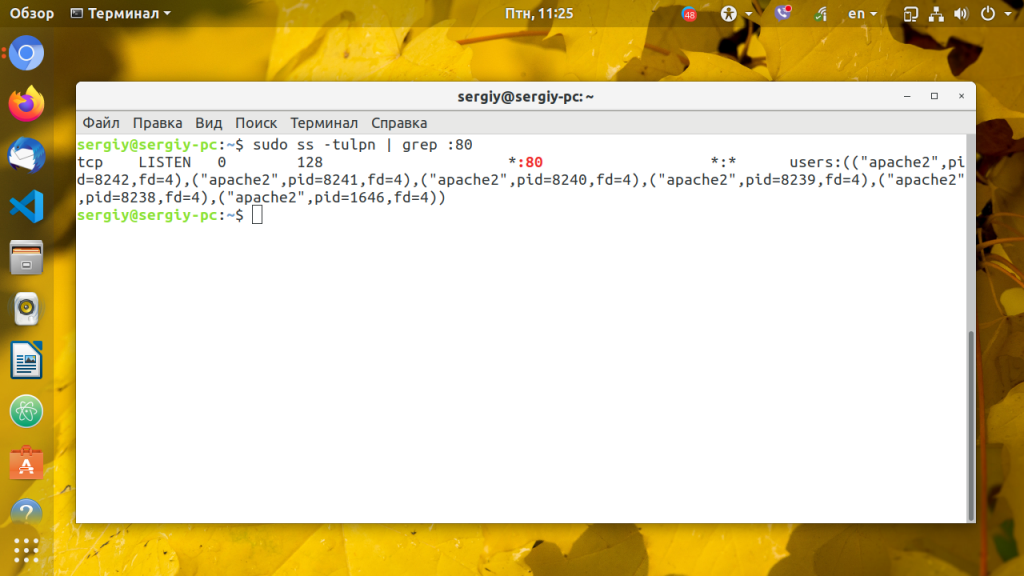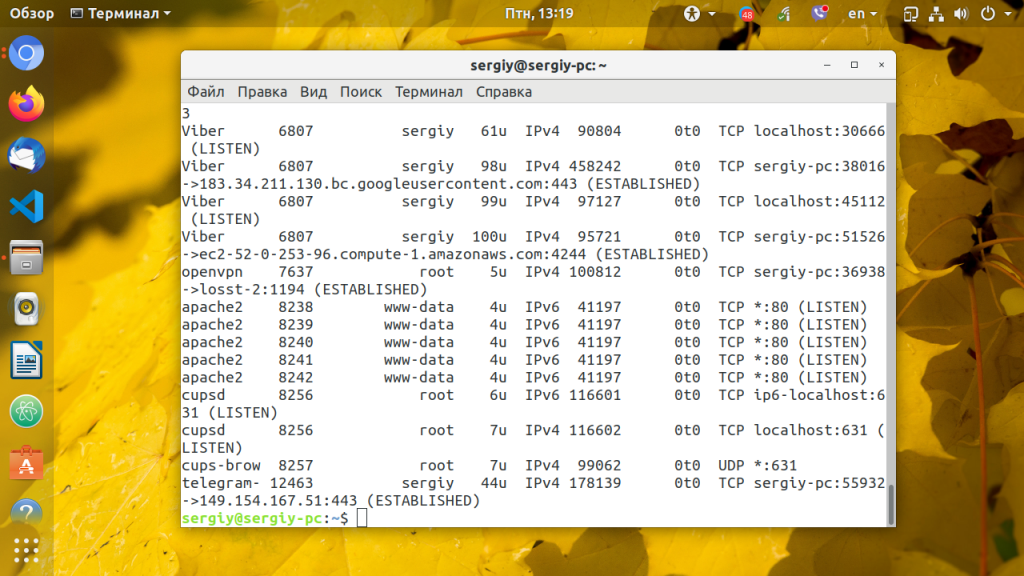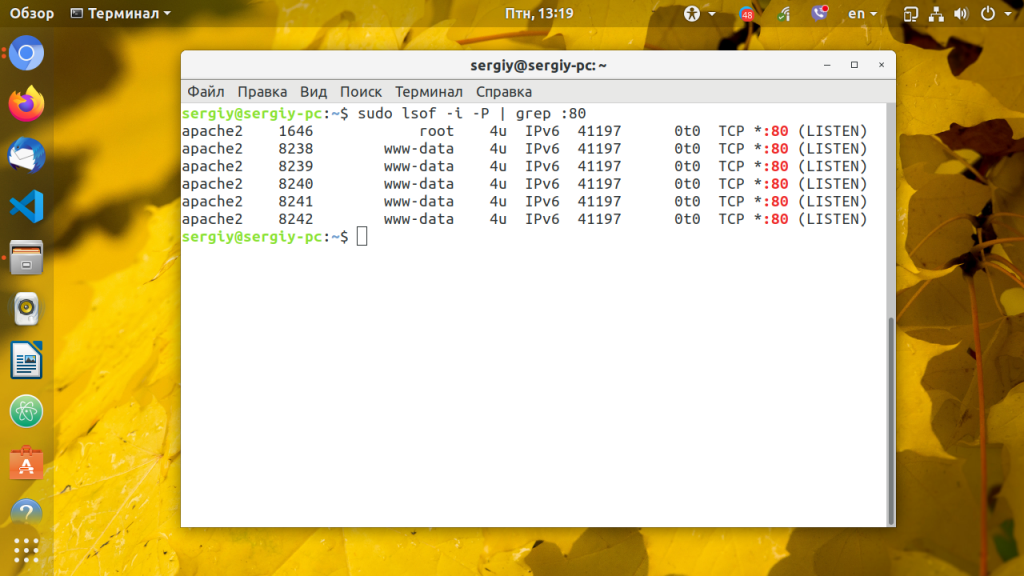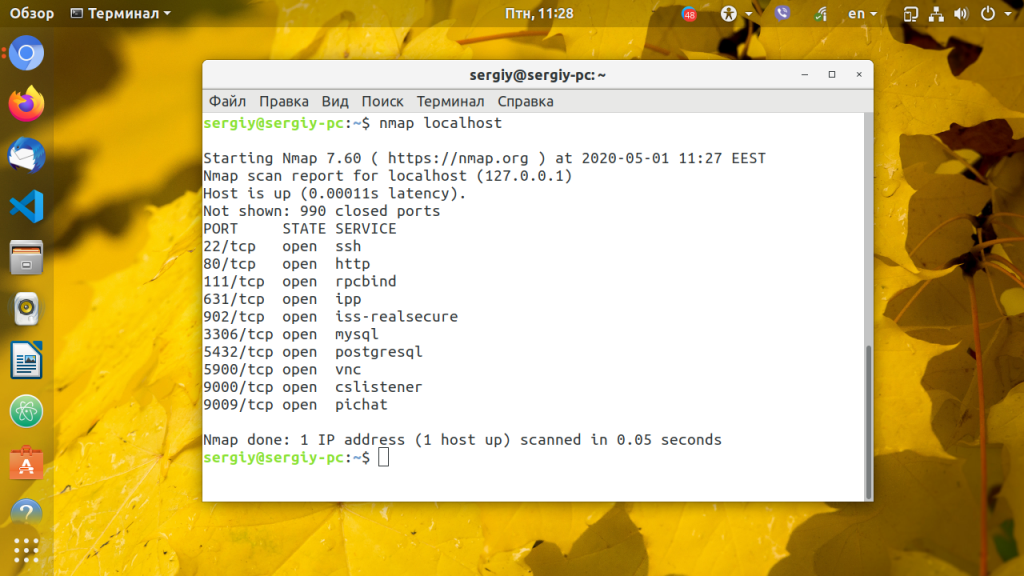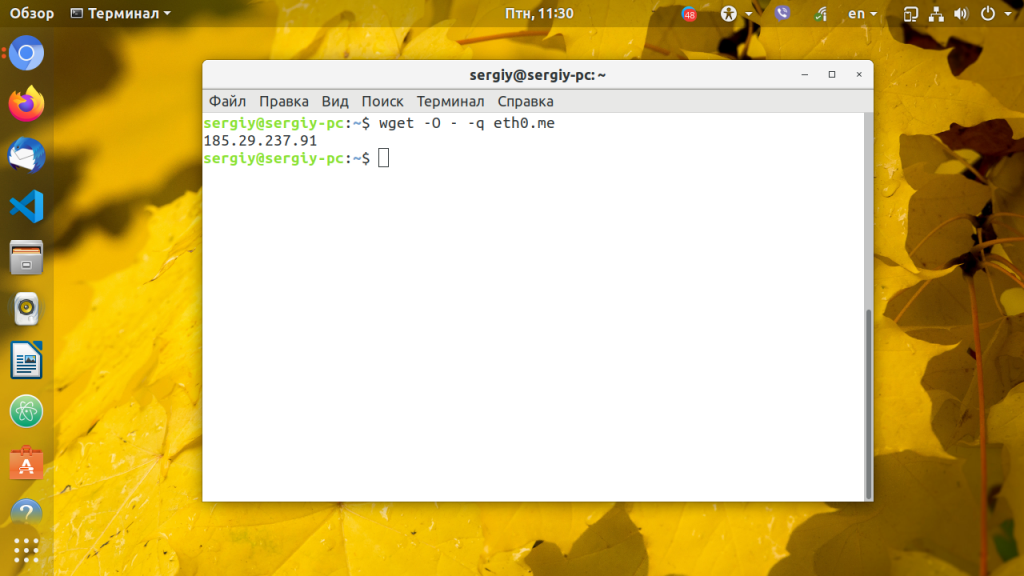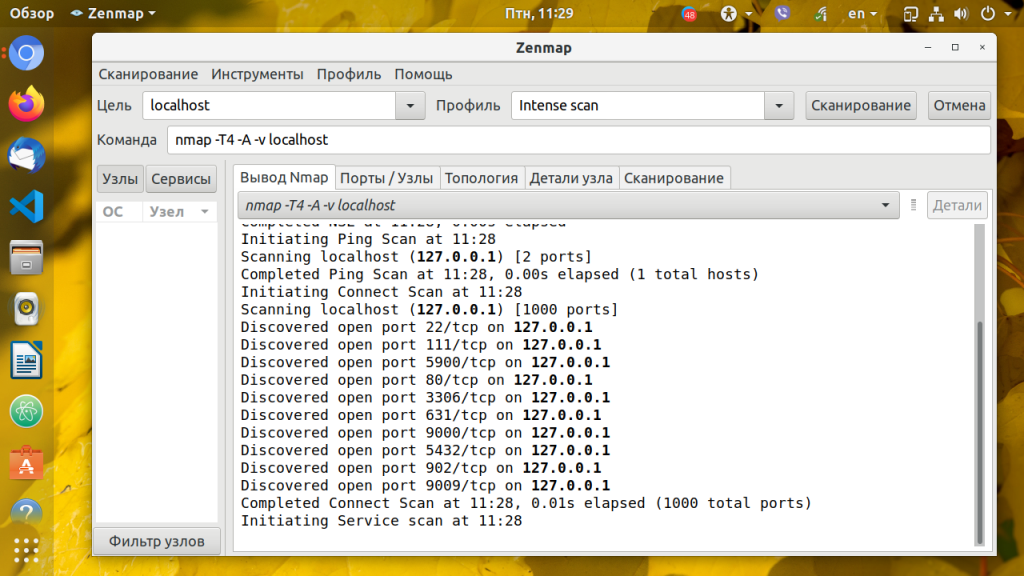- How to check if port is in use on Linux or Unix
- How to check if port is in use in
- Option #1: lsof command
- Option #2: netstat command
- Linux netstat syntax
- FreeBSD/MacOS X netstat syntax
- OpenBSD netstat syntax
- Option #3: nmap command
- A note about Windows users
- Conclusion
- How to check open ports in Linux using the CLI
- What the hell are a TCP and UDP ports?
- Port numbers
- Check open ports in Linux
- Using netstat to list open ports
- Use ss to list open ports
- Listening ports and applications using lsof command
- nmap command
- The open port doesn’t mean anyone from outside can access those ports
- Conclusion
- Как посмотреть открытые порты в Linux
- Как посмотреть открытые порты linux
- 1. netstat
- 3. lsof
- 4. Nmap
- 5. Zenmap
- Выводы
How to check if port is in use on Linux or Unix
H ow do I determine if a port is in use under Linux or Unix-like system? How can I verify which ports are listening on Linux server? How do I check if port is in use on Linux operating system using the CLI?
It is important you verify which ports are listening on the server’s network interfaces. You need to pay attention to open ports to detect an intrusion. Apart from an intrusion, for troubleshooting purposes, it may be necessary to check if a port is already in use by a different application on your servers. For example, you may install Apache and Nginx server on the same system. So it is necessary to know if Apache or Nginx is using TCP port # 80/443. This quick tutorial provides steps to use the netstat, nmap and lsof command to check the ports in use and view the application that is utilizing the port.
| Tutorial details | |
|---|---|
| Difficulty level | Easy |
| Root privileges | Yes |
| Requirements | lsof, ss, and netstat on Linux |
| Est. reading time | 3 minutes |
How to check if port is in use in
To check the listening ports and applications on Linux:
- Open a terminal application i.e. shell prompt.
- Run any one of the following command on Linux to see open ports:
sudo lsof -i -P -n | grep LISTEN
sudo netstat -tulpn | grep LISTEN
sudo ss -tulpn | grep LISTEN
sudo lsof -i:22 ## see a specific port such as 22 ##
sudo nmap -sTU -O IP-address-Here - For the latest version of Linux use the ss command. For example, ss -tulw
Let us see commands and its output in details.
Option #1: lsof command
The syntax is:
$ sudo lsof -i -P -n
$ sudo lsof -i -P -n | grep LISTEN
$ doas lsof -i -P -n | grep LISTEN ### [OpenBSD] ###
Sample outputs:
Fig.01: Check the listening ports and applications with lsof command
Option #2: netstat command
You can check the listening ports and applications with netstat as follows.
Linux netstat syntax
Run netstat command along with grep command to filter out port in LISTEN state:
$ netstat -tulpn | grep LISTEN
The netstat command deprecated for some time on Linux. Therefore, you need to use the ss command as follows:
sudo ss -tulw
sudo ss -tulwn
sudo ss -tulwn | grep LISTEN
Where, ss command options are as follows:
- No ads and tracking
- In-depth guides for developers and sysadmins at Opensourceflare✨
- Join my Patreon to support independent content creators and start reading latest guides:
- How to set up Redis sentinel cluster on Ubuntu or Debian Linux
- How To Set Up SSH Keys With YubiKey as two-factor authentication (U2F/FIDO2)
- How to set up Mariadb Galera cluster on Ubuntu or Debian Linux
- A podman tutorial for beginners – part I (run Linux containers without Docker and in daemonless mode)
- How to protect Linux against rogue USB devices using USBGuard
Join Patreon ➔
- -t : Show only TCP sockets on Linux
- -u : Display only UDP sockets on Linux
- -l : Show listening sockets. For example, TCP port 22 is opened by SSHD server.
- -p : List process name that opened sockets
- -n : Don’t resolve service names i.e. don’t use DNS
FreeBSD/MacOS X netstat syntax
$ netstat -anp tcp | grep LISTEN
$ netstat -anp udp | grep LISTEN
OpenBSD netstat syntax
$ netstat -na -f inet | grep LISTEN
$ netstat -nat | grep LISTEN
Option #3: nmap command
The syntax is:
$ sudo nmap -sT -O localhost
$ sudo nmap -sU -O 192.168.2.13 ##[ list open UDP ports ]##
$ sudo nmap -sT -O 192.168.2.13 ##[ list open TCP ports ]##
Sample outputs:
Fig.02: Determines which ports are listening for TCP connections using nmap
A note about Windows users
You can check port usage from Windows operating system using following command:
netstat -bano | more
netstat -bano | grep LISTENING
netstat -bano | findstr /R /C:»[LISTEING]»
Conclusion
This page explained command to determining if a port is in use on Linux or Unix-like server. For more information see the nmap command and lsof command page online here
🐧 Get the latest tutorials on Linux, Open Source & DevOps via
Источник
How to check open ports in Linux using the CLI
I need to list all open ports in Linux cloud server. How do I check open ports in Linux using the CLI? Can you give me the command to check open ports in Linux operating system?
To troubleshoot server problems and to avoid security issue, one needs to find out open TCP and UDP ports. In this tutorial, you will learn the different Linux commands to check open ports in Linux for auditing and securing the server.
| Tutorial details | |
|---|---|
| Difficulty level | Easy |
| Root privileges | Yes |
| Requirements | Linux command line |
| Est. reading time | 5 minutes |
What the hell are a TCP and UDP ports?
A port is nothing but a 16-bit number between 0 to 65535. For example, TCP port number 22 may be forwarded to the OpenSSH server. Therefore, 22 port number is a way to identify the sshd (OpenSSH server) process.
Port numbers
- The Well Known Ports are those from 0 through 1023.
- The Registered Ports are those from 1024 through 49151.
- The Dynamic and Private Ports are those from 49152 through 65535.
A registered port is a network port assigned by the Internet Assigned Numbers Authority (IANA) and stored in /etc/services file. Use the cat command or grep command/egrep command to view port numbers and service mappings:
Display a list of applications and their ports assigned by IANA
Check open ports in Linux
The procedure to monitor and display open ports in Linux is as follows:
- Open a Linux terminal application
- Use ss command to display all open TCP and UDP ports in Linux.
- Another option is to use the netstat command to list all ports in Linux.
- Apart from ss / netstat one can use the lsof command to list open files and ports on Linux based system.
- Finally, one can use nmap command to check TCP and UDP ports too.
Let us see all commands and examples in details.
Using netstat to list open ports
- No ads and tracking
- In-depth guides for developers and sysadmins at Opensourceflare✨
- Join my Patreon to support independent content creators and start reading latest guides:
- How to set up Redis sentinel cluster on Ubuntu or Debian Linux
- How To Set Up SSH Keys With YubiKey as two-factor authentication (U2F/FIDO2)
- How to set up Mariadb Galera cluster on Ubuntu or Debian Linux
- A podman tutorial for beginners – part I (run Linux containers without Docker and in daemonless mode)
- How to protect Linux against rogue USB devices using USBGuard
Join Patreon ➔
- -t : All TCP ports
- -u : All UDP ports
- -l : Display listening server sockets
- -p : Show the PID and name of the program to which each socket belongs
- -n : Don’t resolve names
- | grep LISTEN : Only display open ports by applying grep command filter.
Use ss to list open ports
The ss command is used to dump socket statistics. It allows showing information similar to netstat. It can display more TCP and state information than other tools. The syntax is:
sudo ss -tulpn
Sample outputs:
Listening ports and applications using lsof command
Let us run the following to check open TCP and UDP ports using the lsof command:
sudo lsof -i -P -n | grep LISTEN
Where,
- -i : Look for listing ports
- -P : Inhibits the conversion of port numbers to port names for network files. Inhibiting the conversion may make lsof run a little faster. It is also useful when port name lookup is not working properly.
- -n : Do not use DNS name
- | grep LISTEN : Again only show ports in LISTEN state using the grep command as filter.
nmap command
In addition, to above commands one can use the nmap command which is an open source tool for network exploration and security auditing. We are going to use nmap to find and list open ports in Linux:
$ sudo nmap -sT -O localhost
$ sudo nmap -sU -O 192.168.2.254 ##[ list open UDP ports ]##
$ sudo nmap -sT -O 127.0.0.1 ##[ list open TCP ports ]##
$ sudo nmap -sTU -O 192.168.2.24
Sample outputs:
The open port doesn’t mean anyone from outside can access those ports
So far, you know how to find and list open TCP and UDP ports on Linux. However, those ports can still be blocked by software, cloud, or hardware firewall. Hence, you need to verify that your corporate firewall is not blocking incoming or outgoing access. For instance on Linux server we list or dump firewall rules using the following syntax:
sudo iptables -S
# IPv6
sudo ip6tables -S
Conclusion
In conclusion, finding out open ports is one of the most fundamental duties of a Linux system administrator for security reasons. Therefore, close down all unwanted ports and configure firewall such as UFW and FirewallD to open or block ports as per your requirements. After reading this tutorial, you should have a good understanding of how to check for open ports in Linux. See IANA’s offical list of TCP, UDP and other ports here for more information.
🐧 Get the latest tutorials on Linux, Open Source & DevOps via
Источник
Как посмотреть открытые порты в Linux
Сетевые порты — это механизм, с помощью которого операционная система определяет какой именно программе необходимо передать сетевой пакет. Здесь можно привести пример с домом. Например, почтальону необходимо доставить посылку. Он доставляет посылку к дому, это IP адрес компьютера. А дальше в самом доме уже должны разобраться в какую квартиру направить эту посылку. Номер квартиры — это уже порт.
Если порт открыт это означает, что какая либо программа, обычно сервис, использует его для связи с другой программой через интернет или в локальной системе. Чтобы посмотреть какие порты открыты в вашей системе Linux можно использовать множество различных утилит. В этой статье мы рассмотрим самые популярные способы посмотреть открытые порты Linux.
Как посмотреть открытые порты linux
1. netstat
Утилита netstat позволяет увидеть открытые в системе порты, а также открытые на данный момент сетевые соединения. Для отображения максимально подробной информации надо использовать опции:
- -l или —listening — посмотреть только прослушиваемые порты;
- -p или —program — показать имя программы и ее PID;
- -t или —tcp — показать tcp порты;
- -u или —udp показать udp порты;
- -n или —numeric показывать ip адреса в числовом виде.
Открытые порты Linux, которые ожидают соединений имеют тип LISTEN, а перед портом отображается IP адрес на котором сервис ожидает подключений. Это может быть определенный IP адрес или */0.0.0.0 что означают любой доступный адрес:
sudo netstat -tulpn
Утилита ss — это современная альтернатива для команды netstat. В отличие от netstat, которая берет информацию из каталога /proc, утилита ss напрямую связывается со специальной подсистемой ядра Linux, поэтому работает быстрее и её данные более точные, если вы хотите выполнить просмотр открытых портов это не имеет большого значения. Опции у неё такие же:
Можно вывести только процессы, работающие на 80-том порту:
sudo ss -tulpn | grep :80
3. lsof
Утилита lsof позволяет посмотреть все открытые в системе соединения, в том числе и сетевые, для этого нужно использовать опцию -i, а чтобы отображались именно порты, а не названия сетевых служб следует использовать опцию -P:
Ещё один пример, смотрим какие процессы работают с портом 80:
sudo lsof -i -P | grep :80
4. Nmap
Программа Nmap — мощный сетевой сканер, разработанный для сканирования и тестирования на проникновение удаленных узлов, но ничего не мешает направить его на локальный компьютер. Утилита позволяет не только посмотреть открытые порты, но и примерно определить какие сервисы их слушают и какие уязвимости у них есть. Программу надо установить:
sudo apt install nmap
Затем можно использовать:
Для простого сканирования можно запускать утилиту без опций. Детальнее о её опциях можно узнать в статье про сканирование сети в Nmap. Эта утилита ещё будет полезна если вы хотите посмотреть какие порты на компьютере доступны из интернета.
Если это публичный сервер, то результат скорее всего не будет отличатся от локального сканирования, но на домашнем компьютере все немного по другому. Первый вариант — используется роутер и в сеть будут видны только порты роутера, еще одним порогом защиты может стать NAT-сервер провайдера. Технология NAT позволяет нескольким пользователям использовать один внешний IP адрес. И так для просмотра открытых внешних портов сначала узнаем внешний ip адрес, для надежности воспользуемся онлайн сервисом:
wget -O — -q eth0.me
Дальше запускаем сканирование:
В результате мы видим, что открыт порт 80 веб-сервера и 22 — порт службы ssh, я их не открывал, эти порты открыты роутером, 80 — для веб-интерфейса, а 22 для может использоваться для обновления прошивки. А еще можно вообще не получить результатов, это будет означать что все порты закрыты, или на сервере установлена система защиты от вторжений IDS. Такая проверка портов может оказаться полезной для того, чтобы понять находится ли ваш компьютер в безопасности и нет ли там лишних открытых портов, доступных всем.
5. Zenmap
Программа Zenmap — это графический интерфейс для nmap. Она не делает ничего нового кроме того, что может делать nmap, просто предоставляет ко всему этому удобный интерфейс. Для её установки выполните:
sudo apt install zenmap
Запустить программу можно из главного меню или командой:
Затем введите адрес localhost в поле Цель и нажмите кнопку Сканирование:
После завершения сканирования утилита вывела список открытых портов Linux.
Выводы
В этой статье мы рассмотрели инструменты, которые вы можете использовать для того чтобы узнать узнать открытые порты linux. Инструментов не так много как для просмотра информации об оперативной памяти или процессоре, но их вполне хватает. А какими программами пользуетесь вы? Напишите в комментариях!
Источник
